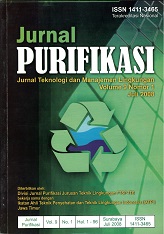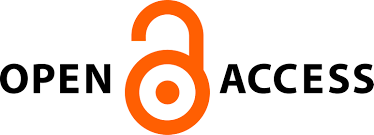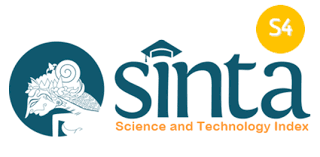PENGARUH LIMBAH CUCIAN PERAK TERHADAP STRUKTUR MIKROANATOMI HEPATOPANKREAS IKAN NILA (Oreochromis niloticus Trewavas)
Main Article Content
Abstract
The wastewater from the washing unit of silverwork industries may contain toxic substances, such as lead, copper, silver, nickel, and mercury. The waste water is generally discharged to a nearby ditch or canal without any treatment. The waste water might cause a harmful effect to the aquatic organisms in the canal. This research was aimed to determine the effect of silver waste water to the microanatomy structure of the hepatopancreas of nila fish (Oreochromis niloticus Trewavas), and to measure the concentration of the waste water which caused the effect. The method used in this research consisted of acclimation of test animals, toxicity tests (orientation test, preceeding test, actual test) for determining the LC50-96 hours. Waste concentration levels of 0; 0,06 %; 0,07 %; 0,07 %; 0,08 %; and 0,09 % were used during this research. The experiment used 25 nila fishes which were divided into five groups. The next steps was preparing the hepatopancreas microanatomy using paraffin method. The cells were dyed with hematoxylin-eosin. The cell damage was analyzed qualitatively and quantitatively. The results of hepatopancreas microanatomy observation showed that the increase of nila fish hepatopancreas cell damage was proportional to the increase of silver wastewater concentration. The damage was shown as the occurence of cloudy swelling, hydrophic degeneration, fatty degeneration, and necrosis. Results of this research also showed that the waste water of the silverwork industry contained lead, copper, silver, nickel, and mercury, which exceeded the waste water quality standards.
Downloads
Article Details
Submission of a manuscript to Jurnal Purifikasi means that the work has never been published in another journal and is not under consideration for publication elsewhere. The author hereby agrees to submit the copyright of the manuscript and its contents to Jurnal Purifikasi, if accepted for publication. Accepted manuscripts will be published in printed form where the ISSN is bound in printed form, not in online form (pdf). Authors are not allowed to publish their work in other forms (journals) without permission from the Jurnal Purifikasi manager.
By submitting a manuscript, the author is deemed to know all the rights and obligations attached to each manuscript.








